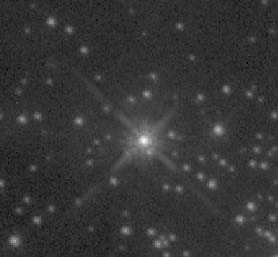Resolving Stars in 30 Doradus
The Melnick 34 region viewed by:
![]() The HST's Wide Field Planetary Camera 2
The HST's Wide Field Planetary Camera 2
![]() The original Wide Field Planetary Camera
The original Wide Field Planetary Camera
![]() The European Southern Observatory
The European Southern Observatory
![]() The Human Eye
The Human Eye
Well over one hundred stars are visible in this Hubble Telescope, WFPC2 view taken in 1995. The resolution is sufficent for quantitative measurements of the brightness of even the fainter stars to be made.
Note: The WFPC2 was substituted for the HST's origingal WFPC during the first servicing mission.

 The Melnick 34 field above is only a third of a minute across - one hundredth the
diameter of the moon. (The arrow indicates a similar sized region on the Moon).
The Melnick 34 field above is only a third of a minute across - one hundredth the
diameter of the moon. (The arrow indicates a similar sized region on the Moon).